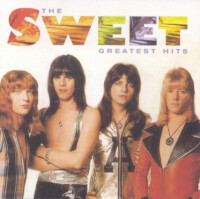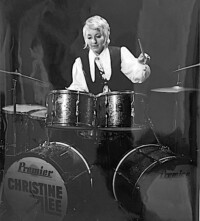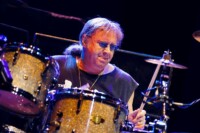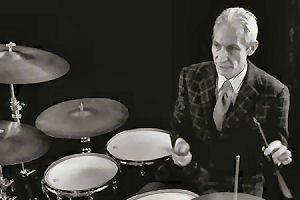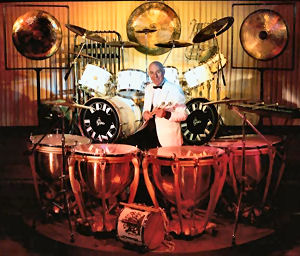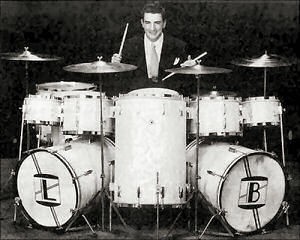 Louie Bellson was born Luigi Paulino Alfredo Francesco Belassoni and with Christian names like that it’s no surprise he was deeply religious. I’ve been lucky enough to meet him several times at various music trade shows and he always came across as being an absolute gentleman. I even remember visiting Remo’s Los Angeles factory in the seventies and standing with the great man and Remo Belli listening to the head-making machine going ‘chunk-a-chunk-a’ as it did its thing while they played polyrhythms against it!
Louie Bellson was born Luigi Paulino Alfredo Francesco Belassoni and with Christian names like that it’s no surprise he was deeply religious. I’ve been lucky enough to meet him several times at various music trade shows and he always came across as being an absolute gentleman. I even remember visiting Remo’s Los Angeles factory in the seventies and standing with the great man and Remo Belli listening to the head-making machine going ‘chunk-a-chunk-a’ as it did its thing while they played polyrhythms against it!
His name was actually Luigi but he preferred to be called Louie (never Louis) and he was born in Rock Falls, Illinois on July 6th 1924. Like several other drummers – Baby Dodds, Buddy Rich, Phil Collins and Mitch Mitchell, to name but a quartet of them – Louie Bellson was a tap dancer. This of course is said to have given rise to his fabulous two-footed bass drum technique (although another factor would have been that he was genuinely ambidextrous and when playing football at school, if he could be bothered, could kick a ball with either foot).
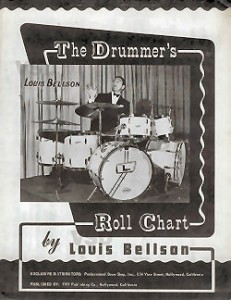 Moline, Illinois (where he grew up and his father owned a music shop) is around three hours away from Chicago and after Louie’s dad had passed on what he knew to his exceptional son, he sent him for drum lessons with Roy C. Knapp. His new teacher came with a considerable recommendation having already taught Gene Krupa, Baby Dodds, Dave Tough and Bobby Christian!
Moline, Illinois (where he grew up and his father owned a music shop) is around three hours away from Chicago and after Louie’s dad had passed on what he knew to his exceptional son, he sent him for drum lessons with Roy C. Knapp. His new teacher came with a considerable recommendation having already taught Gene Krupa, Baby Dodds, Dave Tough and Bobby Christian!
He started out on the piano, an instrument which he said he resented but since he wasn’t just a drummer by any manner of means – he was a composer, bandleader, musical director and jazz and drum educator – he eventually realised the importance of being able to play the instrument. Duke Ellington stated: “he was not only the worlds’ greatest drummer he was also its greatest musician”. Among the 200 records he made as leader, co-leader or sideman, he wrote 300 compositions including ‘Skin Deep’ which remained a sine-qua-non of Duke Ellington’s repertoire long after Louie had left the Orchestra.
His father’s general music shop in Moline is where he began playing the drums among the other musical instruments he found there at three years old. Evidently because he was surrounded by instruments in the shop he did his best to play them all. To prove this virtuosity he collaborated on a musical project called Portofino, which through no fault of his lasted for just three performances on Broadway. Surprisingly he once wrote a piece called ‘Carnaby Street’ which was part of a much larger piece called ‘Louie in London’.
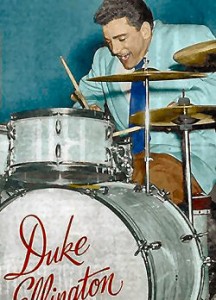 Arguably he was the first to use twin bass drums but even though there are other claims to this accolade on the internet, it was certainly Louie who popularised the idea. So much so that once he left the Orchestra, Duke Ellington wanted his drummers (Sam Woodyard and Rufus Jones) to continue with a two-footed bottom end. Louie’s twin bass drum career began as a 15 year old high school student when as a design project he sketched a revolutionary drumset with a pair of basses for which he was awarded an ‘A’ grade. This was in 1939 and having seen the possibilities offered by his sketch he eventually began to lobby drum companies like Gretsch to make it happen.
Arguably he was the first to use twin bass drums but even though there are other claims to this accolade on the internet, it was certainly Louie who popularised the idea. So much so that once he left the Orchestra, Duke Ellington wanted his drummers (Sam Woodyard and Rufus Jones) to continue with a two-footed bottom end. Louie’s twin bass drum career began as a 15 year old high school student when as a design project he sketched a revolutionary drumset with a pair of basses for which he was awarded an ‘A’ grade. This was in 1939 and having seen the possibilities offered by his sketch he eventually began to lobby drum companies like Gretsch to make it happen.
When joined Benny Goodman, who had some sort of deal with the Gretsch company, he eventually got them, in 1946, to make him the double bass drum set he’d envisaged on paper. The task was made easier because a couple of years earlier he’d beaten 40,000 other drummers to win the ‘Slingerland National Gene Krupa Drum Contest’ when he was seventeen. He cited his major influences as being Papa Jo Jones, Big Sid Catlett and Chick Webb.
The deservedly famous twin-bass Gretsch ‘Broadkaster’ (?) kit had a pair of 20 x 20” basses, with an 18 x 26” tom sitting between them; two 13 x9” and two 11 x 7” toms, and a couple of floor toms: 16 x 18” and 18 x 16”. Just to show that nothing in drumming is new, he stacked his cymbals too. He played with his toe on the bass and his heel on the hi hat, or with his left foot straddling both plates. He even took the legs of his hi hat so he could get the footplates closer together. There’s an interesting story about that large centre tom too. It was discontinued by Louis because it spaced the basses too far apart and was ‘uncomfortable’ for him to play! There’s also a possibly apocryphal story that long before Terry Bozzio and Billy Cobham tried it he had a kit with not two but five bass drums, sometime in the sixties.
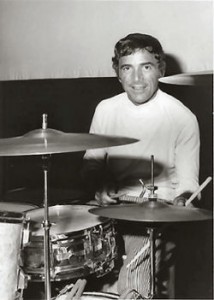 When he left school the war was still on and there was a shortage of musicians because of it. Because of this Louie went straight from full-time education into Ted Fio Rito’s band when his set took up half of the bandstand – the other musicians must have loved him for this! Once he began playing with Benny Goodman he discovered the clarinettist wasn’t too keen on the idea of two bass drums. But having joined Tommy Dorsey he discovered the leader certainly was interested and even specified a revolving riser for him to make more of the set-up so the audience were able to see Louie, his bass drums and his prodigious technique from every angle as he spun around.
When he left school the war was still on and there was a shortage of musicians because of it. Because of this Louie went straight from full-time education into Ted Fio Rito’s band when his set took up half of the bandstand – the other musicians must have loved him for this! Once he began playing with Benny Goodman he discovered the clarinettist wasn’t too keen on the idea of two bass drums. But having joined Tommy Dorsey he discovered the leader certainly was interested and even specified a revolving riser for him to make more of the set-up so the audience were able to see Louie, his bass drums and his prodigious technique from every angle as he spun around.
From 1943 to 1952 he played with a great deal of Jazz ‘royalty’ including Benny Goodman, Tommy Dorsey, Harry James and Duke Ellington. He stayed with Benny for two years and credits him with teaching him how to play in a Big Band situation and how to swing! Next he joined the Dorsey band and he 1950 he joined the Harry James band, which would in modern parlance be like playing in The Beatles, The Stones, The Who and Genesis. In his early days he’d find himself playing to 2,000 people at the Hollywood Palladium or 14 or 15,000 people at a Naval, Army or Air Force base.
Interestingly he didn’t actually use two bass drums when he was keeping time. This of course was the era of the ‘feathered’ (i.e. lightly-played) bass drum which was there to be felt by the band and reinforce what the double bass was doing. Louie used the bass drum for accents while using the snare, ride and hi hat to keep time.
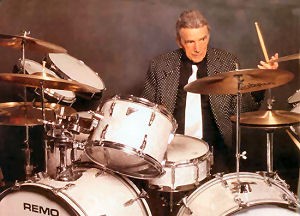 There was a numbered of ‘Limited Edition’ Louie Bellson ‘signature’ snare drum made by Remo around the turn of the century which was meant to have been available here at the time Louie was touring in the UK. However, as these things happen, due to a glitch they turned up just in time for our hero to go home. That said I recently saw the one owned by Bobby Orr. It’s an extremely good and highly-collectable instrument – available in any colour you like so long as it’s Louie’s signature White Marine Pearl!
There was a numbered of ‘Limited Edition’ Louie Bellson ‘signature’ snare drum made by Remo around the turn of the century which was meant to have been available here at the time Louie was touring in the UK. However, as these things happen, due to a glitch they turned up just in time for our hero to go home. That said I recently saw the one owned by Bobby Orr. It’s an extremely good and highly-collectable instrument – available in any colour you like so long as it’s Louie’s signature White Marine Pearl!
He appeared at the White House to play for The President more times than anyone other than Bob Hope and the list of people who used his services is illustrious, lengthy and a who’s who of jazz – Duke Ellington, Count Basie, Benny Goodman, Tommy Dorsey, Harry James, Woody Herman, Benny Carter, Sarah Vaughan, Ella Fitzgerald, Oscar Peterson, Art Tatum, Dizzy Gillespie, Gerry Mulligan, Stan Getz, Hank jones, Zoot Sims, Sonny Stitt, Milt Jackson, Clark Terry, Louie Armstrong, Gene Krupa, Lionel Hampton, Shelly Manne, Billy Cobham, James Brown, Sammy Davis jnr, Tony Bennett, Mel Tormé, Wayne Newton and Pearl Bailey. If there’s any luminary I haven’t mentioned it’s because it’s safe to assume he never had time to get together with them! He made an album with Buddy Rich called ‘Hope You’re Ready For This’ (and another with Eric Delaney called ‘Repercussion’) but he also did something which to my knowledge no one else has – he led Buddy’s orchestra when he was having trouble with his back. Talking of orchestras, Louie had two at the same time – one on the East Coast of America and another on the West!
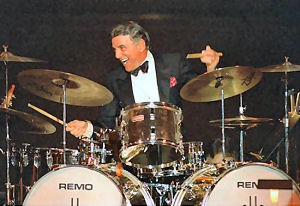 Duke Ellington called him “the world’s greatest drummer” and also told him “In the beginning there was lightning and thunder, and the thunder, that’s you”. Leonard Feather the renowned jazz historian went further describing him as “one of the most phenomenal drummers in history, with all the requirements for perfection”.
Duke Ellington called him “the world’s greatest drummer” and also told him “In the beginning there was lightning and thunder, and the thunder, that’s you”. Leonard Feather the renowned jazz historian went further describing him as “one of the most phenomenal drummers in history, with all the requirements for perfection”.
As you can imagine he has received a great many accolades including being voted into Modern Drummer and PAS’s Halls Of Fame, becoming a fellow of Yale University, gaining a Doctorate from Northern Illinois University and the ‘American Jazz Master’s Award’ where the chairperson stated “His colossal talents have helped to write the history of Jazz in America.”
To get the essence of Louie first listen to ‘Skin Deep’ then to anything else he’s ever done.
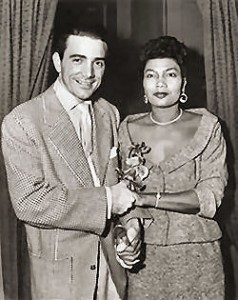 Louie was the only white guy in the Ellington band and was introduced to his first wife, the singer and entertainer Pearl Bailey, by one of his fellow musicians. He met her in Chicago and married her in London after a whirlwind courtship which lasted for just four days. Immediately after he left the Ellington band for a time to become his new wife’s Musical Director. Their marriage lasted from 1952 until Pearl’s death in 1990. He married his second wife Francine in 1992.
Louie was the only white guy in the Ellington band and was introduced to his first wife, the singer and entertainer Pearl Bailey, by one of his fellow musicians. He met her in Chicago and married her in London after a whirlwind courtship which lasted for just four days. Immediately after he left the Ellington band for a time to become his new wife’s Musical Director. Their marriage lasted from 1952 until Pearl’s death in 1990. He married his second wife Francine in 1992.
Louie Bellson died in Los Angeles on February 14th, 2009 – he was 84 years old.
Bob Henrit
September 2014

